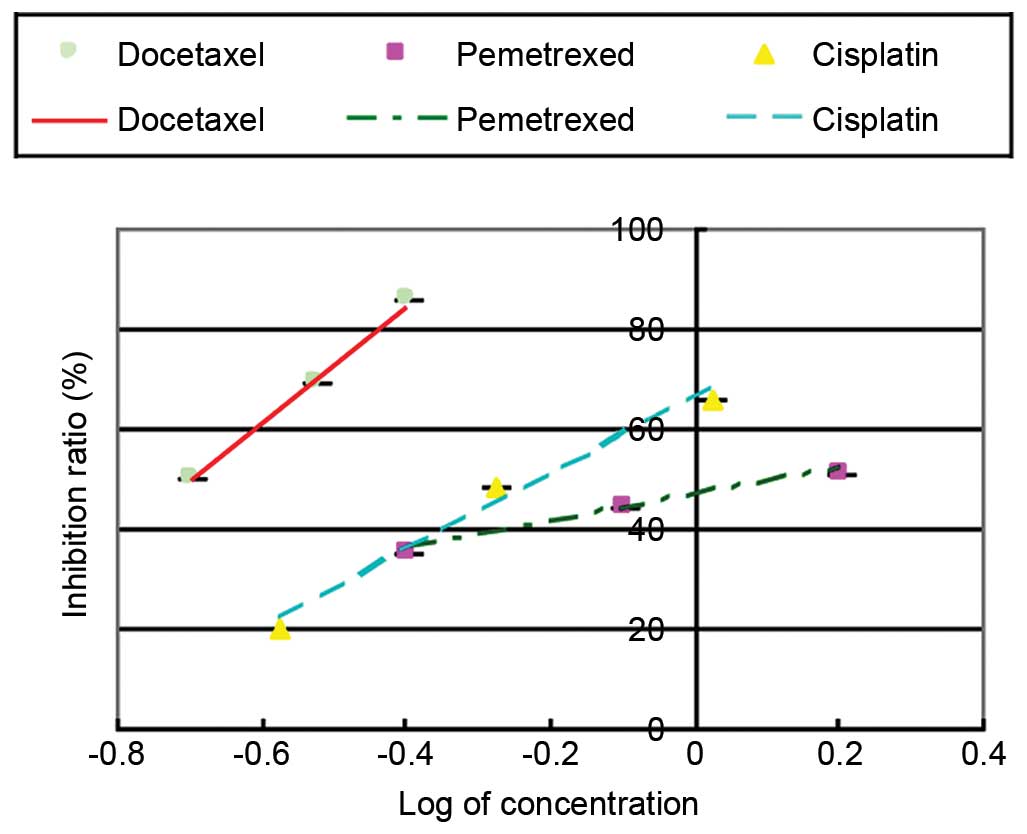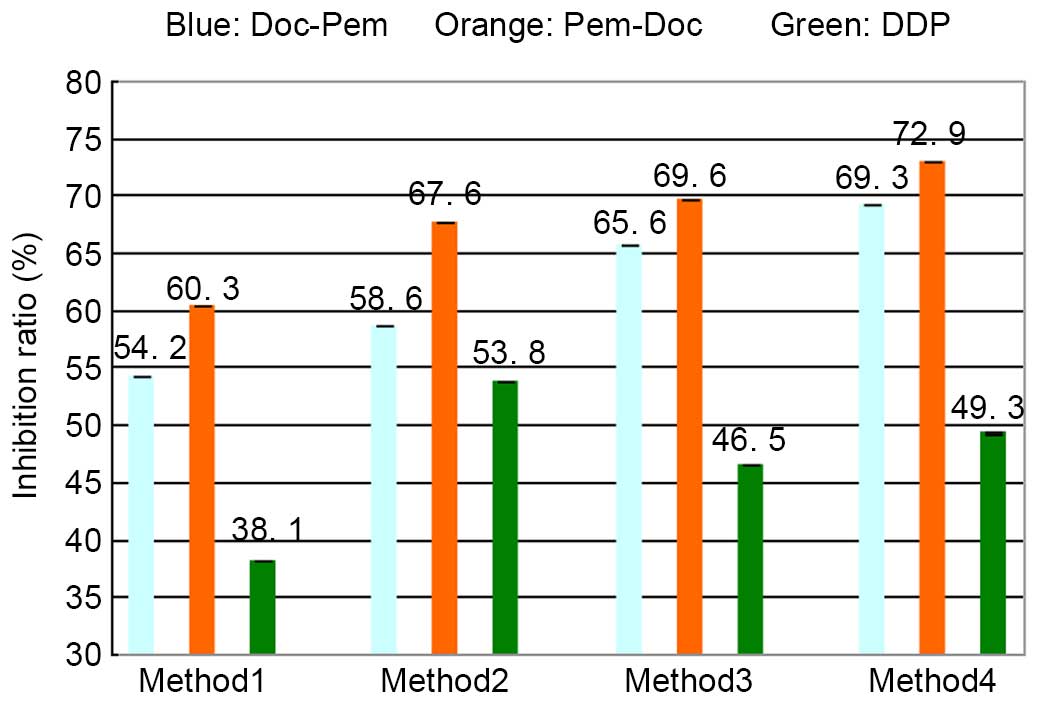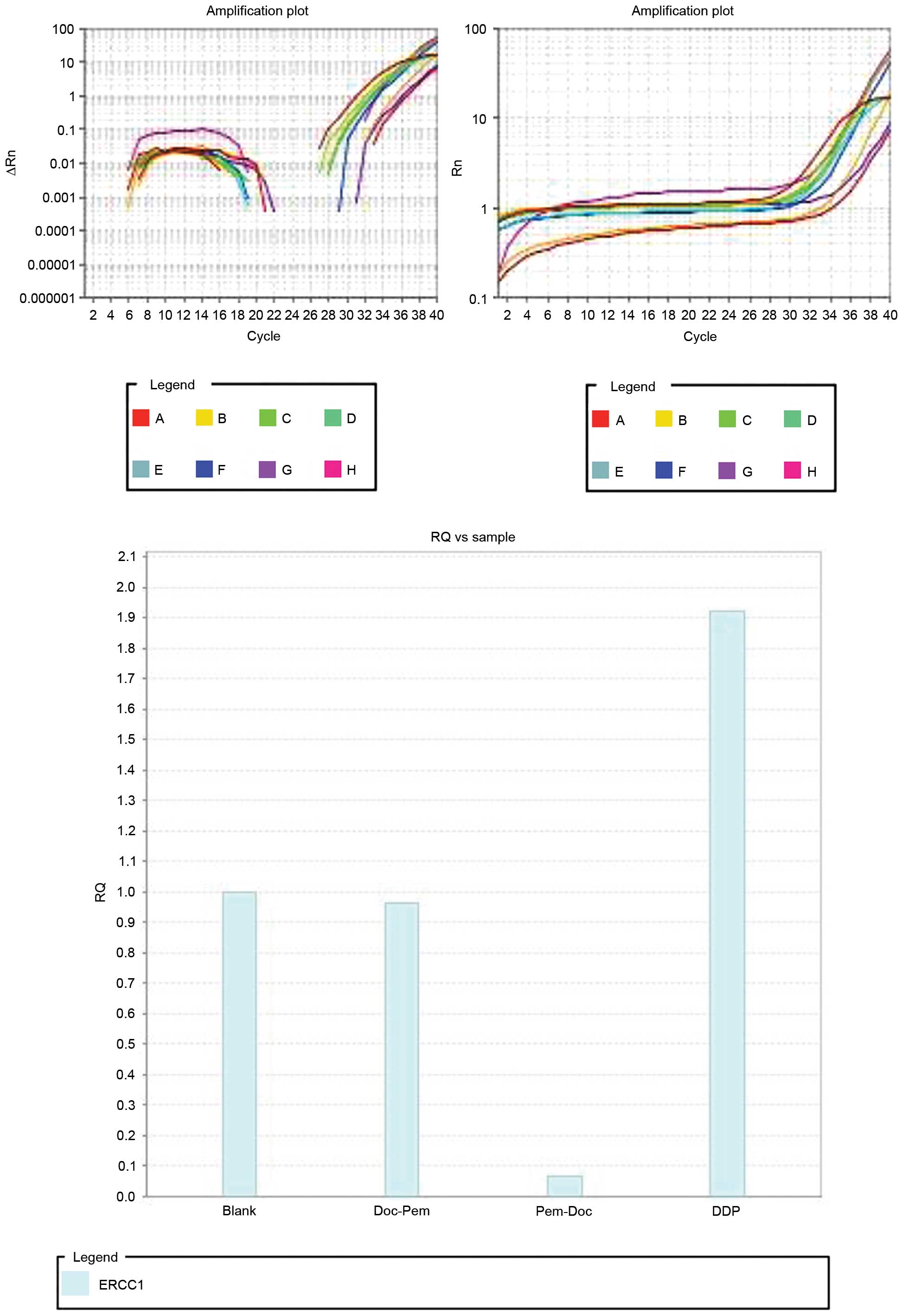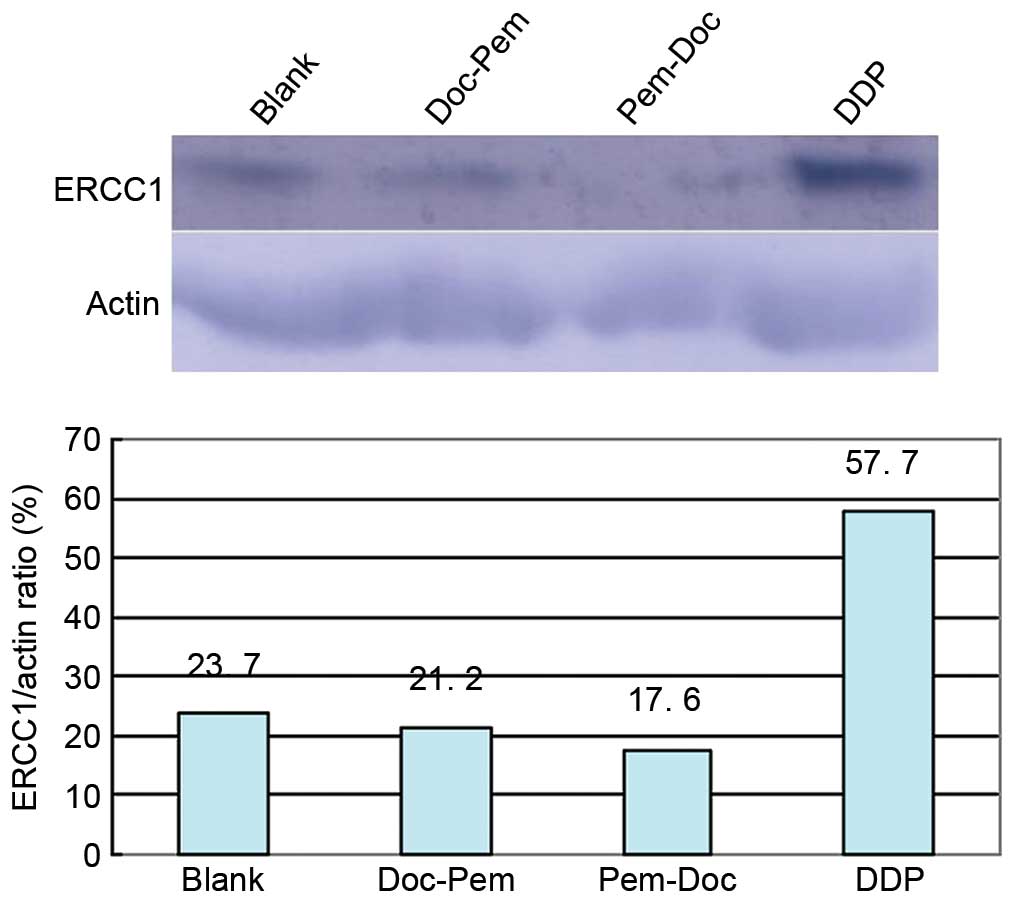|
1
|
Takita H, Edgerton F, Marabella P, Conway
D and Harguindey S: Platinum-based combination chemotherapy in
non-small cell lung carcinoma. Cancer. 48:1528–1530. 1981.
View Article : Google Scholar : PubMed/NCBI
|
|
2
|
Belani CP: Docetaxel in combination with
platinums in patients with advanced non-small-cell lung cancer.
Oncology (Williston Park). 11(8): Suppl 8. S42–S45. 1997.
|
|
3
|
Stinchcombe TE, Borghaei H, Barker SS,
Treat JA and Obasaju C: Pemetrexed with platinum combination as a
backbone for targeted therapy in non-small-cell lung cancer. Clin
Lung Cancer. 17:1–9. 2016. View Article : Google Scholar : PubMed/NCBI
|
|
4
|
Al-Farsi A and Ellis PM: Treatment
paradigms for patients with metastatic non-small cell lung cancer,
squamous lung cancer: First, second, and third-line. Front Oncol.
4:1572014. View Article : Google Scholar : PubMed/NCBI
|
|
5
|
Gatzemeier U, von Pawel J, Gottfried M,
ten Velde GP, Mattson K, de Marinis F, Harper P, Salvati F, Robinet
G, Lucenti A, et al: Phase III comparative study of high-dose
cisplatin versus a combination of paclitaxel and cisplatin in
patients with advanced non-small cell lung cancer. J Clin Oncol.
18:3390–3399. 2000.PubMed/NCBI
|
|
6
|
Scagliotti GV, De Marinis F, Rinaldi M,
Crinò L, Gridelli C, Ricci S, Matano E, Boni C, Marangolo M, Failla
G, et al: Phase III randomized trial comparing three platinum-based
doublets in advanced non-small-cell lung cancer. J Clin Oncol.
20:4285–4291. 2002. View Article : Google Scholar : PubMed/NCBI
|
|
7
|
Schiller JH, Harrington D, Belani CP,
Langer C, Sandler A, Krook J, Zhu J and Johnson DH: Eastern
Cooperative Oncology Group: Comparison of four chemotherapy
regimens for advanced non-small-cell lung cancer. N Engl J Med.
346:92–98. 2002. View Article : Google Scholar : PubMed/NCBI
|
|
8
|
Smit EF, van Meerbeeck JP, Lianes P,
Debruyne C, Legrand C, Schramel F, Smit H, Gaafar R, Biesma B,
Manegold C, et al: Three-arm randomized study of two
cisplatin-based regimens and paclitaxel plus gemcitabine in
advanced non-small-cell lung cancer: A phase III trial of the
European organisation for research and treatment of cancer lung
cancer group-EORTC 08975. J Clin Oncol. 21:3909–3917. 2003.
View Article : Google Scholar : PubMed/NCBI
|
|
9
|
Fossella F, Pereira JR, von Pawel J,
Pluzanska A, Gorbounova V, Kaukel E, Mattson KV, Ramlau R, Szczesna
A, Fidias P, et al: Randomized, multinational, phase III study of
docetaxel plus platinum combination versus vinorelbine plus
cisplatin for advanced non-small-cell lung cancer: The TAX 326
study group. J Clin Oncol. 21:3016–3024. 2003. View Article : Google Scholar : PubMed/NCBI
|
|
10
|
Shepherd FA, Dancey J, Ramlau R, Mattson
K, Gralla R, O'Rourke M, Levitan N, Gressot L, Vincent M, Burkes R,
et al: Prospective randomized trial of docetaxel versus best
supportive care in patients with non-small-cell lung cancer
previously treated with platinum-based chemotherapy. J Clin Oncol.
18:2095–2103. 2000.PubMed/NCBI
|
|
11
|
Fossella FV, DeVore R, Kerr RN, Crawford
J, Natale RR, Dunphy F, Kalman L, Miller V, Lee JS, Moore M, et al:
Randomized phase III trial of docetaxel versus vinorelbine or
ifosfamide in patients with advanced non-small-cell lung cancer
previously treated with platinum-containing chemotherapy regimens.
The TAX 320 Non-Small cell lung cancer study group. J Clin Oncol.
18:2354–2362. 2000.PubMed/NCBI
|
|
12
|
Hanna N, Shepherd FA, Fossella FV, Pereira
JR, De Marinis F, von Pawel J, Gatzemeier U, Tsao TC, Pless M,
Muller T, et al: Randomized phase 111 trial of pemetrexed versus
doeetaxel in patients with non-small-cell lung cancer previously
treated with chemotherapy. J Clin Onco1. 22:1589–1597. 2004.
View Article : Google Scholar
|
|
13
|
Shepherd FA, Pereira J Rodrigues, Ciuleanu
T, Tan EH, Hirsh V, Thongprasert S, Campos D, Maoleekoonpiroj S,
Smylie M, Martins R, et al: Erlotinib in previously treated
non-small-cell lung cancer. N Engl J Med. 353:123–132. 2005.
View Article : Google Scholar : PubMed/NCBI
|
|
14
|
Di Maio M, Perrone F, Chiodini P, Gallo C,
Camps C, Schuette W, Quoix E, Tsai CM and Gridelli C: Individual
patient data meta-analysis of docetaxel administered once every3
weeks compared with once every week second-line treatment of
advanced non-small-cell lung cancer. J Clin Oncol. 25:1377–1382.
2007. View Article : Google Scholar : PubMed/NCBI
|
|
15
|
Peterson P, Park K, Fossella F, Gatzemeier
U, John W and Scagliotti GV: Is pemetrexed more effective in
adenocarcinoma and large cell lung cancer than in squamous cell
carcinoma? A retrospective analysis of a phase III trial of
pemetrexed vs docetaxel in previously treated patients with
advanced non-small cell lung cancer (NSCLC). J Thorac Oncol.
2:(Suppl 4). s8512007. View Article : Google Scholar
|
|
16
|
Scagliotti GV, Parikh P, von Pawel J,
Biesma B, Vansteenkiste J, Manegold C, Serwatowski P, Gatzemeier U,
Digumarti R, Zukin M, et al: Phase III study comparing cisplatin
plus gemcitabine with cisplatin plus pemetrexed in
chemotherapy-naive patients with advanced-stage non-small-cell lung
cancer. J Clin Oncol. 26:3543–3551. 2008. View Article : Google Scholar : PubMed/NCBI
|
|
17
|
Scagliotti G, Hanna N, Fossella F,
Sugarman K, Blatter J, Peterson P, Simms L and Shepherd FA: The
differential efficacy of pemetrexed according to NSCLC histology: A
review of two phase III studies. Oncologist. 14:253–263. 2009.
View Article : Google Scholar : PubMed/NCBI
|
|
18
|
Zhang QC, Jiang SJ, Zhang S and Ma XB:
Histone deacetylase inhibitor trichostatin A enhances antitumor
effects of docetaxel or erlotinib in A549 cell line. Asian Pac J
Cancer Prev. 13:3471–3476. 2012. View Article : Google Scholar : PubMed/NCBI
|
|
19
|
Wu DM, Zhang P, Xu GC, Tong AP, Zhou C,
Lang JY and Wang CT: Pemetrexed induces G1 phase arrest and
apoptosis through inhibiting Akt activation in human non small lung
cancer cell line A549. Asian Pac J Cancer Prev. 16:1507–1513. 2015.
View Article : Google Scholar : PubMed/NCBI
|
|
20
|
Tsai MS, Weng SH, Chen HJ, Chiu YF, Huang
YC, Tseng SC, Kuo YH and Lin YW: Inhibition of p38 MAPK-dependent
excision repair cross-complementing 1 expression decreases the DNA
repair capacity to sensitize lung cancer cells to etoposide. Mol
Cancer Ther. 11:561–571. 2012. View Article : Google Scholar : PubMed/NCBI
|
|
21
|
Liu YP, Ling Y, Qi QF, Zhang YP, Zhang CS,
Zhu CT, Wang MH and Pan YD: The effects of ERCC1 expression levels
on the chemosensitivity of gastric cancer cells to platinum agents
and survival in gastric cancer patients treated with
oxaliplatin-based adjuvant chemotherapy. Oncol Lett. 5:935–942.
2013.PubMed/NCBI
|
|
22
|
Cai Y, Yan X, Zhang G, Zhao W and Jiao S:
The predictive value of ERCC1 and p53 for the effect of
panobinostat and cisplatin combination treatment in NSCLC.
Oncotarget. 6:18997–19005. 2015. View Article : Google Scholar : PubMed/NCBI
|
|
23
|
Livak KJ and Schmittgen TD: Analysis of
relative gene expression data using real-time quantitative PCR and
the 2(−Delta Delta C(T)) method. Methods. 25:402–408. 2001.
View Article : Google Scholar : PubMed/NCBI
|
|
24
|
Fleeman N, Bagust A, McLeod C, Greenhalgh
J, Boland A, Dundar Y, Dickson R, Smith C Tudur, Davis H, Green J
and Pearson M: Pemetrexed for the first-line treatment of locally
advanced or metastatic non-small cell lung cancer. Health Technol
Assess. 14:(Suppl 1). S47–S53. 2010. View Article : Google Scholar
|
|
25
|
Pereira JR, Cheng R, Orlando M, Kim JH and
Barraclough H: Elderly subset analysis of randomized phase III
study comparing pemetrexed plus carboplatin with docetaxel plus
carboplatin as first-line treatment for patients with locally
advanced or metastatic non-small cell lung cancer. Drugs R D.
13:289–296. 2013. View Article : Google Scholar : PubMed/NCBI
|













